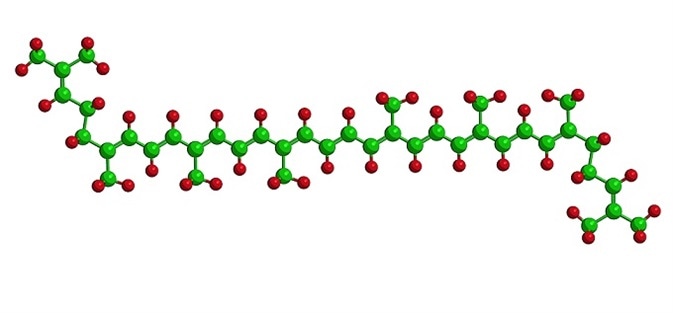
Encapsulation of Lycopene
Role of antioxidants in disease prevention
Oxidative stress is known to be a major cause of premature aging and disease1. It is caused by the accumulation of free radicals that oxidize blood vessel walls, protein molecules, DNA, carbohydrates, and membrane lipids, changing the way cells function.
 © Raimundo79/Shutterstock.com
© Raimundo79/Shutterstock.comFree radicals are by-products of natural cell metabolism and are thereby unavoidable, but they can be neutralized by antioxidants. The human body naturally produces antioxidants for this purpose, but these are generally not sufficient to fully protect us from free radical damage.
It is widely believed that an increase in antioxidants can reduce the risk of developing diseases such as cancer, cardiovascular disease, Alzheimer's disease and macular degeneration2. Antioxidant protection can be enhanced by eating a diet rich in foods that contain antioxidants, such as vitamin C, vitamin E, carotene, lycopene. These include fruit and vegetables, beans and nuts and caffeine-containing products. Indeed, health benefits have been reported among people routinely eating antioxidant-rich foods3.
There is consequently great interest in boosting the amounts of antioxidants in manufactured food products. One of the compounds being investigated for addition to foodstuffs to increase their antioxidant potential is lycopene.
Lycopene
Lycopene is a naturally occurring chemical comprising a long carbon chain with eleven conjugated double bonds. It is a powerful antioxidant4, being more than twice as effective at mopping up free radicals as ß-carotene. It occurs in a variety of fruits and vegetables, most notably those that are a red color. It is obtained in the most usable form from cooked tomatoes.
There has been much research into providing a formulation of lycopene that contains high amounts of lycopene yet is suitable for use in subsequent processing. One such methodology receiving particular attention is encapsulation.
Encapsulation
Encapsulation is the process by which active agents are contained within a carrier material. It is typically used to improve the stability and preserve the quality of the contents by protecting them from interaction with their environment. It may also be used to improve or control delivery of the contents.
The food industry is increasingly using encapsulation to introduce health-promoting bioactive molecules, such as antioxidants, minerals, vitamins, phytosterols, into foods.
Encapsulation allows such food additives to be stored without losing quality and improves their delivery by preventing interactions with other food ingredients5. The carrier materials most widely used for encapsulation in food applications are polysaccharides.
Research into improved encapsulation methodologies continues to find solutions that maintain high quantities of the food additive without compromising the quality of the final food product.
To date the encapsulation of lycopene has not been as successful as expected, since only a relatively low lycopene content has been achieved. Furthermore, control of the rate of release of lycopene from the capsules has not been mastered. A novel combination for the encapsulation of lycopene has recently been proposed — alginate-calcium beads.
Alginate-calcium bead encapsulation of lycopene
Encapsulation in alginate-calcium beads is one of the more cost-effective and environmentally-friendly methods of encapsulation. Furthermore, alginate-calcium is non-toxic, biocompatible, and thermally and chemically stable making it suitable for use in the food industry. It has already been effectively used in drug-delivery systems.
A recent study successfully encapsulated high quantities of lycopene in alginate beads7. A Bruker Minispec mq20 low-field proton nuclear magnetic resonance (LF-NMR) spectrometer was used to measure proton transverse relaxation times and diffusion coefficient.
It was found that the amount of lycopene included in each capsule was affected by the precise composition of the bead. Higher lycopene content was achieved by including chitosan within the beads used for encapsulation.
The addition of chitosan reduced molecular mobility and the diffusion coefficient, which allowed more of the lycopene to be maintained during encapsulation. In addition, it was shown that the rate of release of the lycopene from the capsule could be modified by adjusting the composition of the beads7.
Using this encapsulation process would therefore allow lycopene formulations to be tailored to specific applications.
Using LF-NMR, the study was able to determine that this novel carrier for the encapsulation of lycopene represents a promising methodology for producing high-lycopene formulations suitable for use in a range of subsequent technological processes.
References
- Labat-Robert J and Robert L. Longevity and aging. Role of free radicals and xanthine oxidase. A review. Pathol Biol. 2014;62:61–66.
- Sen L, et al. Research progress of natural antioxidants in foods for the treatment of diseases. Food Sci Hum Wellness 2014;3:110–116.
- Szymanska R, et al. Plant-Derived Antioxidants in Disease Prevention. Oxidative Medicine and Cellular Longevity 2016;2016:ID1920208.
- Kelkel M, et al. Antioxidant and anti-proliferative properties of lycopene. Free Radic Res. 2011;45(8):925-940.
- Zeller BL, et al. Trends in development of porous carbohydrate food ingredients for use in flavor encapsulation. Trends Food Sci Technol. 1999;9:389–394.
- Aguirre Calvo TR, et al. Stability and release of an encapsulated solvent-free lycopene extract in alginate-based beads. LWT Food Sci Technol. 2017;77:406–12.
- Aguirre Calvo TR and Santagapita PR. Encapsulation of a free‑solvent extract of lycopene in alginate-Ca(II) beads containing sugars and biopolymers. Chem. Biol. Technol. Agric. 2017;4:16.
About Bruker
Bruker is market leader in analytical magnetic resonance instruments including NMR, EPR and preclinical magnetic resonance imaging (MRI). Bruker's product portfolio in the field of magnetic resonance includes NMR, preclinical MRI ,EPR and Time-Domain (TD) NMR. In addition.
Bruker delivers the world's most comprehensive range of research tools enabling life science, materials science, analytical chemistry, process control and clinical research. Bruker is also the leading superconductor magnet and ultra high field magnet manufacturer for NMR and MRI solutions.
Sponsored Content Policy: News-Medical.net publishes articles and related content that may be derived from sources where we have existing commercial relationships, provided such content adds value to the core editorial ethos of News-Medical.Net which is to educate and inform site visitors interested in medical research, science, medical devices and treatments.
Last updated: Jun 19, 2018 at 10:44 AM























.png)











No hay comentarios:
Publicar un comentario